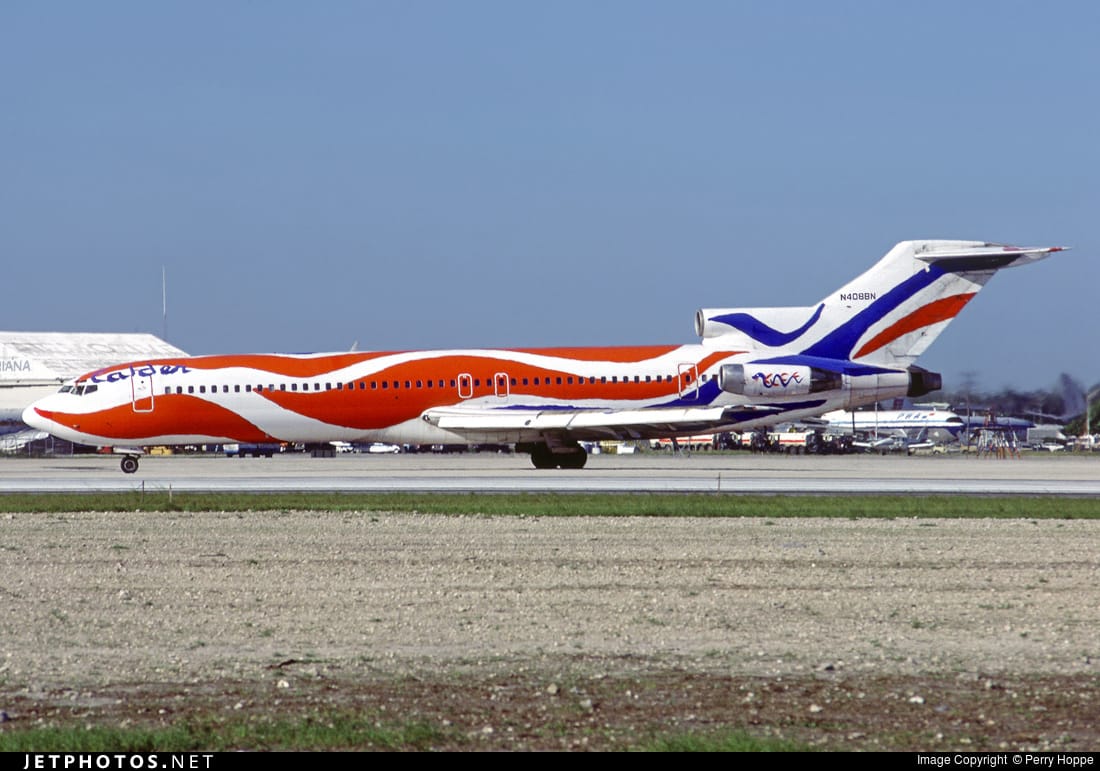From Patriotic Icon to Hollywood Action Star: The Incredible Journey of Boeing 727 N408BN
In the annals of aviation history, there are aircraft that fade quietly into retirement, and then there are those that become legends. The Boeing 727 with registration N408BN is one such legend—a jet that soared not just through the clouds, but across American culture, patriotism, and even the silver screen. Originally painted by the celebrated American artist Alexander Calder to commemorate the United States Bicentennial in 1976, this aircraft would later find a second life as a movie prop in a Will Smith blockbuster. Its journey is a testament to how airplanes can transcend utility, becoming symbols of national pride and even cinematic spectacle.
Celebrating America: Calder’s Bicentennial Masterpiece
The story of N408BN begins at the intersection of art, aviation, and American history. In the mid-1970s, Braniff International Airways—a carrier known for breaking conventions with its bold visual identity—commissioned the legendary artist Alexander Calder to create a unique livery to celebrate the 200th birthday of the United States. Calder, renowned for his vibrant mobiles and public sculptures, delivered a design that transformed the Boeing 727 into a flying canvas. Swathes of red, white, and blue gracefully danced across the fuselage, punctuated by Calder’s signature organic shapes and whimsy.
When the “Bicentennial Jet” took to the skies in 1976, it wasn’t just a mode of transport—it was a symbol of American innovation, optimism, and unity. Passengers who boarded N408BN were treated not only to Braniff’s high-flying service but also to a piece of living art, celebrating the spirit of an entire nation. The jet became an instant icon, gracing airports across the U.S. and capturing the imagination of avgeeks and patriots alike.
From Service to Stardom: The Aircraft’s Second Act
As the years rolled on, both Braniff and its fleet of colorful jets faced the turbulence of deregulation and changing market forces. By the 1980s, the Bicentennial 727 was retired from commercial service. But N408BN’s story was far from over. Instead of being scrapped or left to rust in a desert boneyard, the jet would soon find new purpose—this time, in Hollywood.
In the late 1990s, film producers were on the hunt for a real jetliner to use in a high-octane action sequence for a major blockbuster starring Will Smith. They needed an authentic airframe—one that could be rigged for pyrotechnics and dramatic stunts. N408BN, with its storied past and robust Boeing 727 bones, was chosen for the role. The aircraft was stripped of its Calder livery, repainted, and modified for its cinematic debut. When it finally appeared on screen, viewers watched in awe as the 727 became the centerpiece of a fiery explosion—its final flight, immortalized in film.
Why This Matters: The Cultural and Technical Impact
The journey of N408BN highlights several fascinating facets of aviation and culture:
- Art Meets Engineering: Calder’s livery wasn’t just paint—it was a groundbreaking collaboration between the art world and aerospace engineering. The jet became one of the world’s first “flying art galleries,” inspiring future generations of airline liveries and corporate branding.
- Preserving History Through Pop Culture: Rather than being forgotten, N408BN’s inclusion in a blockbuster film preserved its legacy, introducing new audiences to its unique story. The aircraft became an ambassador for aviation history in an entirely new arena.
- Technical Adaptability: The transformation of a retired jetliner into a movie prop showcases the ingenuity of both aviation and film professionals. Modifying a commercial airliner for stunt work requires meticulous planning, safety protocols, and a deep understanding of aircraft structure—underscoring the versatility of Boeing’s classic 727 design.
The Aviation Industry’s Love Affair with the Boeing 727
To appreciate N408BN’s journey, it’s important to understand why the Boeing 727 holds a special place in aviation history. First launched in the early 1960s, the 727 was Boeing’s answer to airlines’ demand for a versatile, short-to-medium range jet. Its trijet configuration, high-lift wing design, and rear airstairs made it ideal for operations at airports with shorter runways or limited ground infrastructure. The 727 democratized jet travel for millions and became a workhorse for airlines around the globe.
For Braniff, the 727 was the perfect canvas for experimentation. The airline’s “End of the Plain Plane” campaign, which featured vibrant color schemes by designers like Emilio Pucci and Alexander Girard, culminated in Calder’s Bicentennial masterpiece. N408BN embodied not just the technical prowess of Boeing, but also the audacious spirit of 1970s America.
Passengers, Technology, and the Power of Storytelling
For those lucky enough to have flown on the Bicentennial Jet, the experience was unforgettable. Boarding N408BN wasn’t just a trip from point A to B—it was a celebration of art, aviation, and American pride. Passengers became part of a unique historical moment, surrounded by Calder’s sweeping lines and bold colors. Even after its commercial life ended, the jet’s role in film extended its reach to millions more, connecting audiences to aviation in a visceral, cinematic way.
The story of N408BN also highlights how technology enables transformation. The robust design of the Boeing 727 allowed it to transition from passenger service to movie prop. The ability to safely repurpose an airliner for explosive stunts on a film set demonstrates both the durability of the airframe and the technical prowess of those involved. It’s a testament to the idea that aircraft, like stories, can be continually reimagined and reinterpreted.
Conclusion: A Legacy That Soars On
N408BN’s journey from a Bicentennial showpiece to a Hollywood action star is more than just a footnote in aviation history—it’s a vivid reminder of the enduring connections between technology, culture, and storytelling. Whether gracing the skies as a symbol of American pride or captivating audiences in a pulse-pounding movie scene, this Boeing 727 transcended its original purpose, becoming a legend in its own right.
For plane enthusiasts, the tale of N408BN is a case study in how aircraft can be both functional machines and powerful cultural icons. It’s a reminder to look beyond the rivets and jet engines, and to appreciate the stories that give wings to history. The next time you see a classic airliner—whether in an airport museum or lighting up the big screen—remember the journey of the Bicentennial Jet. Its legacy, much like the spirit it once celebrated, continues to soar.


